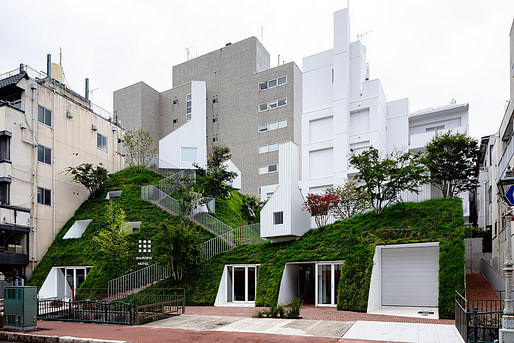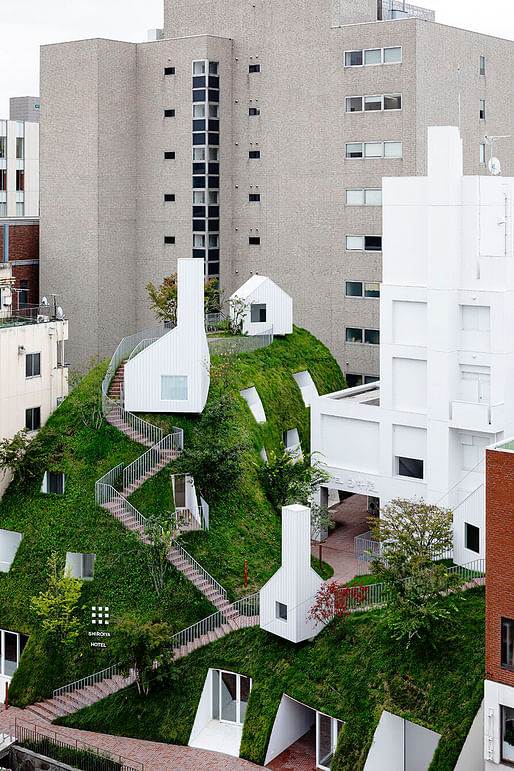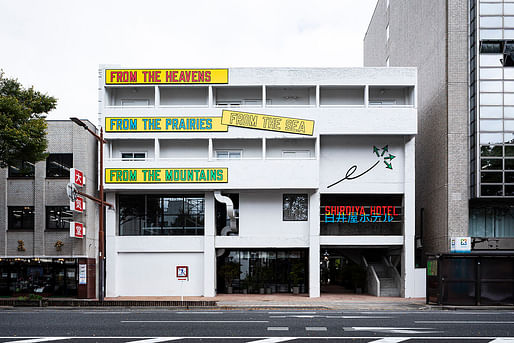

A vacant hotel that had been in operation for 300 years until its closure in 2008 has been resurrected by Sou Fujimoto Architects.
Situated in the center of Maebashi, a city about two hours northwest of Tokyo, Shiroiya Hotel’s revamp is part of a wider rejuvenation of the city, a plan spearheaded by Maebashi native and businessman, Hitoshi Tanaka. He has been working to push the city in a more creative direction that is interesting and fun for young entrepreneurs. Aside from the hotel, Tanaka has helped develop one of Maebashi’s fading shopping streets by adding an acclaimed craft pasta shop and cake shop. He is also active in the city’s local politics.

Tanaka bought the Shiroiya Hotel in 2014, and rather than demolishing the existing 1970s-era, concrete structure, he sought to revitalize the old hotel and make it a landmark destination for Maebashi. Having worked with Sou Fujimoto Architects in the past, Tanaka enlisted the group to bring his vision to life.
The new Shiroiya Hotel consists of two structures; the “Heritage Tower,” which is a renovation of the previous building, housing seventeen rooms, and the contrasting “Green Tower”, an organic structure that contains eight rooms and a few retail spaces cloaked by verdant vegetation with four small white cabins sitting on top. The Heritage Tower contains the hotel’s reception area, restaurant, and lounge on the ground floor.
Fujimoto stripped most of the 75 existing rooms in the original hotel and added a glass roof to fill the massive space with natural light. Concrete beams zig-zag around the interior, intertwining with the sculptural staircase that runs from the lobby to the fourth floor. These features are also accompanied by an installation titled Lightning Pipes by Argentine artist Leandro Erlich.

“The pipes are a symbol of the water pipes that are always hidden inside walls and go through all buildings as veins of fluids,’ says Erlich. ‘I was very much inspired by the approach Sou had to the old hotel and how he uncovered the concrete structure. I see the concrete structure as the bones of the organism.”
A number of other artists and designers were employed to shape the interiors. For the façade, an expressive, typographic artwork by American artist Lawrence Weiner was added. Out of the 25 guest rooms at Shiroiya Hotel, four were uniquely made by Fujimoto, Erlich, and designers Jasper Morrison and Michele de Lucchi.

All of the rooms in the Green Tower feature balconies that are cut into the slope of the hill. Brick stairs cut through the Green Tower providing access to the small cabins, where one contains a Finnish sauna.
According to Wallpaper, Tanaka is currently involved in two more projects in Maebashi, with one being a mixed-use building containing a community space and small apartments and the other currently under wraps.
The Shiroiya Hotel was completed in late 2020 and opened to guests in mid-December.
For more about Sou Fujimoto and his work, take a listen to this recent episode from the Archinect Sessions podcast, A Conversation with Sou Fujimoto on the "Futures of the Future"
No Comments
Block this user
Are you sure you want to block this user and hide all related comments throughout the site?
Archinect
This is your first comment on Archinect. Your comment will be visible once approved.